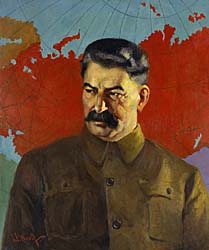
|

At five feet, five inches in height, Joseph Stalin was the small, unassuming-looking dictator of the Soviet Union. Yet he was the absolute ruler of some 180 million people, whose empire spanned across Europe and Asia from Poland to the Pacific Ocean. After suffering humiliating defeats by Hitler on the Russian front in 19411942, Stalin's Red Army systematically vanquished the Nazis in Eastern Europe as far west as Berlin. At the Potsdam Conference in July 1945, when an American mentioned this achievement, Stalin replied matter-of-factly that Czar Alexander had gotten to Paris. Inevitably, Stalin's allies were left to decipher his postwar intentions. Soviet expansionism lurked behind them all and was the political motive that prevented the Russians from engaging in meaningful peace agreements. In Moscow in 1947, Secretary of State George Marshall found Stalin to be "completely evasive" about substantive issues, while maintaining a calm and gracious exterior. "Stalin's greatness as a dissimulator was an integral part of his greatness as a statesman," wrote Russian expert George Kennan. "An unforewarned visitor would never have guessed what depths of calculation, ambition, love of power, jealousy, cruelty, and sly vindictiveness lurked behind this unpretentious facade."
Joseph Stalin, 1879-1953
Samuel J. Woolf (1880-1948)
Oil on canvas
60.9 x 50.8 cm. (24 x 20 in.)
December 20, 1937, for TIME magazine
National Portrait Gallery, Smithsonian Institution
Gift of Muriel Woolf Hobson
NEXT portrait
BACK to "George C. Marshall: Soldier of Peace"
Past Exhibitions | National Portrait Gallery Home
|

